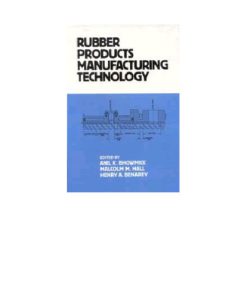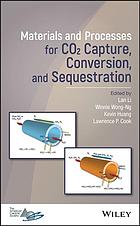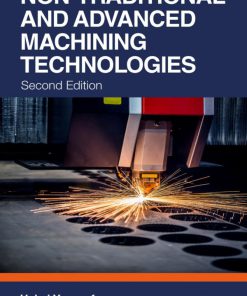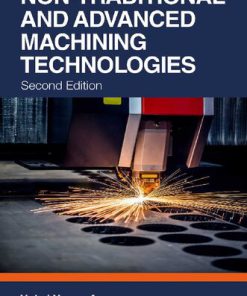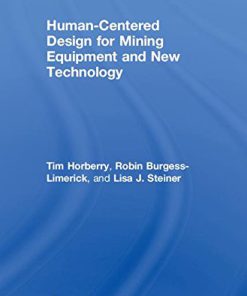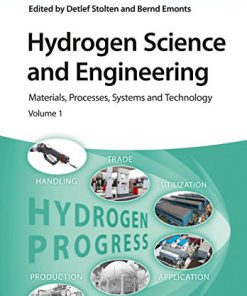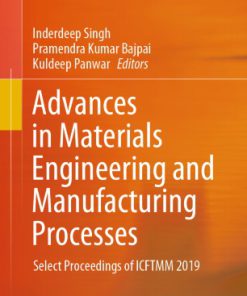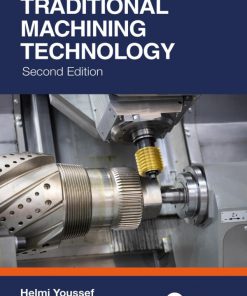Manufacturing Technology Materials Processes and Equipment 1st Edition by Helmi Youssef 1439897089 9781439897089
$50.00 Original price was: $50.00.$25.00Current price is: $25.00.
Manufacturing Technology Materials, Processes, and Equipment 1st Edition by Helmi A. Youssef – Ebook PDF Instant Download/DeliveryISBN: 1439897089, 9781439897089
Full download Manufacturing Technology Materials, Processes, and Equipment 1st Edition after payment.
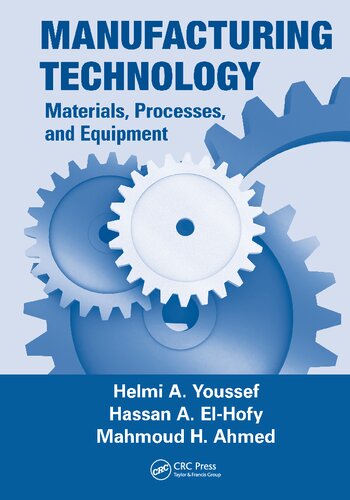
Product details:
ISBN-10 : 1439897089
ISBN-13 : 9781439897089
Author: Helmi A. Youssef
This new edition textbook provides comprehensive knowledge and insight into various aspects of manufacturing technology, processes, materials, tooling, and equipment. Its main objective is to introduce the grand spectrum of manufacturing technology to individuals who will be involved in the design and manufacturing of finished products and to provide them with basic information on manufacturing technologies. Manufacturing Technology: Materials, Processes, and Equipment, Second Edition, is written in a descriptive manner, where the emphasis is on the fundamentals of the process, its capabilities, typical applications, advantages, and limitations.
Manufacturing Technology Materials, Processes, and Equipment 1st Table of contents:
1 Introduction to Manufacturing Technology
1.1 Importance of Manufacturing Technology
1.2 Selection of Materials and Manufacturing Processes
1.2.1 Selection of Materials for Manufacturing
1.2.2 Selection of Manufacturing Processes
1.2.3 Classification of Manufacturing Processes
1.2.3.1 Smelting and Casting Processes
1.2.3.2 Plastic Forming Processes for Metallic Materials
1.2.3.3 Powder Metallurgy and Ceramic Processing
1.2.3.4 Machining Processes
1.2.3.5 Joining Processes
1.2.3.6 Surface Treatment Processes
1.2.3.7 Heat Treatment Processes
1.2.3.8 Assembly
1.2.3.9 Additive Manufacturing Processes
1.2.3.10 Modern Manufacturing Processes
1.2.3.11 Complementary Processes
1.3 Company Organization
1.4 Role of Computers in Modern Manufacturing Technology
1.5 Planning for Manufacturing
1.6 Accuracy of Manufacturing Processes
1.7 Economical and Environmental Considerations
1.8 Health and Safety Aspects
Review Questions
Bibliography
2 Properties of Engineering Materials
2.1 Introduction
2.2 Physical Properties
2.2.1 Density
2.2.2 Thermal Properties
2.2.3 Electrical and Magnetic Properties
2.2.4 Optical Properties
2.2.5 Chemical and Corrosion Properties
2.3 Mechanical Properties
2.3.1 Strength
2.3.2 Ductility and Brittleness
2.3.3 Toughness
2.3.4 Hardness
2.3.5 Fatigue
2.3.6 Creep
2.4 Manufacturing (Fabricating) Properties
2.4.1 Castability
2.4.2 Ductility, Malleability, Workability, and Formability
2.4.3 Machinability
2.4.4 Grindability
2.4.5 Weldability
2.4.6 Heat Treatability
Review Questions
Problems
Bibliography
3 Structure of Metals and Alloys
3.1 Introduction
3.2 Lattice Structure of Metals
3.2.1 Space Lattices
3.2.2 Allotropic (Polymorphic) Crystals (Changes in Crystal Structure)
3.2.3 Effect of Lattice Structure on Density of Metals
3.3 Imperfections in Lattice Structure
3.3.1 Point Defects
3.3.2 Line Defects (Dislocations)
3.3.3 Surface or Planar Defects (Grain Boundaries)
3.3.4 Volume or Bulk Defects
3.4 Solidification of Metals and Alloys
3.4.1 Solidification of Pure Metals and Alloys
3.4.2 Solid Solutions
3.4.3 Phase Diagrams
3.4.4 Iron–Carbon Phase Diagram
Review Questions
Problems
Bibliography
4 Engineering Materials and Their Applications
4.1 Introduction
4.2 Classification of Engineering Materials
4.3 Ferrous Metals and Alloys
4.3.1 Steels and Steel Alloys
4.3.1.1 Steel Designation
4.3.1.2 Steels and Typical Applications
4.3.2 Cast Irons
4.3.2.1 General Characteristics
4.3.2.2 Common Types of Cast Irons
4.4 Nonferrous Metals and Alloys
4.4.1 Aluminum and Aluminum Alloys
4.4.2 Magnesium and Magnesium Alloys
4.4.3 Zinc and Zinc Alloys
4.4.4 Lead, Tin, and Lead–Tin Alloys (White Metals)
4.4.5 Copper and Copper Alloys
4.4.6 Nickel and Nickel Alloys
4.4.7 Titanium and Titanium Alloys
4.4.8 Superalloys
4.4.9 Refractory Metals
4.4.10 Noble Metals
4.5 Newly Born Engineering Materials
4.5.1 Nanomaterials
4.5.2 Amorphous Alloys
4.5.3 Metal Foams
4.5.4 Shape Memory Alloys
Review Questions
Bibliography
5 Heat Treatment of Metals and Alloys
5.1 Introduction
5.2 Heat Treatment of Steels
5.2.1 Simplified Iron-Iron Carbide Equilibrium Diagram
5.2.2 Effect of Alloying Elements
5.2.3 Time–Temperature–Transformation Diagram (T–T–T Diagram)
5.3 Basic Heat Treatment Operations of Steels
5.3.1 Annealing Processes
5.3.2 Normalizing
5.3.3 Tempering
5.3.4 Anticrack Hardening Techniques
5.3.4.1 Austempering (Isothermal Quenching)
5.3.4.2 Martempering (Interrupted or Marquenching)
5.3.5 Full-Depth Hardening (through Hardening)
5.3.6 Surface Hardening Techniques
5.3.6.1 Methods of Selective Hardening
5.3.6.2 Diffusion Methods (Thermochemical Hardening)
5.4 Heat Treatment of Cast Iron
5.5 Heat Treatment of Nonferrous Alloys and Stainless Steels (Precipitation Hardening)
Review Questions
Bibliography
6 Smelting of Metallic Materials
6.1 Introduction
6.2 Smelting of Ferrous Metals
6.2.1 Blast Furnace
6.2.2 Steel Refining Processes
6.2.2.1 Basic Oxygen Converter (L-D Process)
6.2.2.2 Electric Arc Furnace
6.2.2.3 Induction Furnaces
6.2.2.4 Ingot Casting
6.2.2.5 Continuous Casting
6.2.3 Cast Iron Refining: Cupola Furnace
6.3 Smelting and Extraction of Nonferrous Metals
6.3.1 Aluminum
6.3.2 Copper
6.3.3 Titanium
6.3.4 Miscellaneous Metals
Review Questions
Bibliography
7 Casting of Metallic Materials
7.1 Introduction and Classification
7.2 Historical Development of Casting
7.3 Expendable Mold Casting Processes
7.3.1 Sand Casting
7.3.1.1 Patterns
7.3.1.2 Cores
7.3.1.3 Gating System
7.3.1.4 Types of Sand Molds
7.3.1.5 Sand Molding Techniques
7.3.2 Shell Molding
7.3.3 Vacuum Molding
7.3.4 Slurry Molding
7.3.5 Plaster Molding
7.3.6 Ceramic Molding
7.3.7 Expendable Mold, Expendable Pattern Casting
7.3.7.1 Investment Casting (Lost-Wax Process)
7.3.7.2 Evaporative Casting (Lost-Foam Process)
7.4 Permanent Mold Castings
7.4.1 Die Casting Processes
7.4.1.1 Gravity Die Casting
7.4.1.2 Slush Casting
7.4.1.3 Low-Pressure Die Casting
7.4.1.4 Vacuum Die Casting
7.4.1.5 Pressure Die Casting
7.4.2 Centrifugal Casting
7.4.2.1 True Centrifugal Casting
7.4.2.2 Semi-Centrifugal Casting
7.4.2.3 Centrifuging (Centrifuged Casting)
7.5 Melting Furnaces
7.5.1 Cupolas
7.5.2 Crucible Furnace
7.6 Cleaning and Finishing of Castings
7.7 Quality of Castings
7.8 Modeling of Casting
7.8.1 Fluidity
7.8.2 Fluid Flow through the Gating System
7.8.3 Mold Filling Time
7.8.4 Solidification Time
7.9 Impact of Recent Developments in Materials on Casting Technology
7.9.1 Casting of Composites
7.9.2 Casting of Functionally Graded Materials
7.9.3 Casting of Porous (Foam) Metals
Review Questions
Problems
Bibliography
8 Fundamentals of Metal Forming
8.1 Introduction
8.2 Simple Stresses and Strains
8.2.1 Elastic Stresses and Strains
8.2.2 Plastic Stresses and Strains
8.2.2.1 Poisson’s Ratio
8.2.3 True Stress and True Strain
8.2.4 Empirical Relations for the Stress–Strain Curve
8.2.4.1 Idealized Stress–Strain Curves
8.3 Two- and Three-Dimensional Stresses and Strains
8.3.1 Principal Stresses and Strains
8.3.1.1 Mean (Hydrostatic) Stress and Stress Deviators
8.3.1.2 Principal Strains
8.3.2 General Stress–Strain Relations in the Elastic Range
8.3.3 Some Special Conditions of Stress and Strain
8.4 Yield Criteria
8.5 General Plastic Stress–Strain Relations (Theory of Plasticity)
8.5.1 Plastic Work
8.6 Effect of Temperature on Plastic Deformation
8.7 Cold, Warm, and Hot Forming
8.7.1 Cold Forming
8.7.2 Warm Forming
8.7.3 Hot Forming
8.8 Effect of Strain Rate on Plastic Deformation
8.9 Superplasticity
8.10 Effect of Friction and Lubrication in Metal Forming
Review Questions
Problems
Bibliography
9 Bulk Forming of Metallic Materials
9.1 Introduction
9.2 Classification of Forming Processes
9.3 Forging Processes
9.3.1 Open-Die Forging
9.3.2 Close-Die (Impression) Forging
9.3.3 Special Forging Processes
9.3.3.1 Rotary Swaging
9.3.3.2 Radial Forging
9.3.3.3 Orbital Forging
9.3.3.4 Coining
9.3.4 Forging Equipment
9.3.4.1 Mechanical Presses
9.3.4.2 Hydraulic Presses
9.3.4.3 Hammers
9.3.5 Forging Defects
9.3.6 Modeling of Forging Processes
9.3.6.1 Direct Compression (Upsetting) in Plane Strain
9.3.6.2 Upsetting a Solid Cylindrical Specimen
9.3.6.3 Modeling of Impression-Die Forging
9.4 Rolling Processes
9.4.1 Flat Rolling
9.4.2 Section Rolling
9.4.3 Tube Rolling
9.4.3.1 Rotary Piercing (Mannesmann Process)
9.4.3.2 Three-Roll Rotary Piercing
9.4.3.3 The Pilger Process
9.4.3.4 Rolling of Seamed Tubes
9.4.4 Special Rolling Processes
9.4.5 Rolling Defects
9.4.6 Modeling of Flat Rolling
9.4.7 Determination of the Neutral Point
9.5 Extrusion
9.5.1 Classification of Extrusion Processes
9.5.1.1 Direct and Indirect Extrusion
9.5.1.2 Hydrostatic Extrusion
9.5.1.3 Tube Extrusion
9.5.1.4 Porthole Die Extrusion
9.5.1.5 Cold Extrusion and Impact Extrusion
9.5.1.6 Conform Extrusion
9.5.2 Extrusion Equipment
9.5.3 Extrusion Defects
9.5.4 Modeling of Direct Extrusion
9.6 Rod, Wire, and Tube Drawing
9.6.1 Classification of Drawing Processes
9.6.1.1 Rod Drawing
9.6.1.2 Wire Drawing
9.6.1.3 Tube Drawing
9.6.2 The Drawing Die
9.6.3 Modeling of the Drawing Process
Review Questions
Problems
Bibliography
10 Sheet Metal Forming Processes
10.1 Introduction and Classification
10.2 Shearing Processes
10.2.1 Classification of Shearing Processes
10.2.1.1 Open Contour Shearing
10.2.1.2 Closed Contour Shearing
10.2.2 Shearing Mechanism
10.3 Bending Processes
10.3.1 Bending Parameters
10.3.2 Springback in Bending
10.3.3 Residual Stresses in Bending
10.3.4 Bending Equipment
10.3.4.1 Press Brake
10.3.4.2 Roll Bending Machines
10.3.4.3 Contour Roll Forming
10.4 Stretch Forming
10.4.1 Stretch Forming Machines and Accessories
10.5 Deep Drawing
10.5.1 Blank Holding Pressure
10.5.2 Ironing
10.5.3 Deep-Drawing Force
10.5.4 Limiting Drawing Ratio
10.5.5 Effect of Anisotropy
10.5.6 Redrawing
10.6 Rubber Pad Forming (Flexible-Die Forming)
10.6.1 Rubber Pad Forming Techniques
10.7 Hydroforming (Fluid-Forming Processes)
10.8 Spinning
10.8.1 Conventional Spinning
10.8.2 Flow Turning (Shear Spinning)
10.8.3 Tube Spinning
10.9 Superplastic Forming of Sheets
10.10 Blow Forming and Vacuum Forming
10.11 Thermoforming Methods
10.11.1 Superplastic Forming/Diffusion Bonding Process
10.12 Sheet Metal Formability
10.12.1 Testing for Formability
10.12.2 Forming Limit Diagrams
People also search for Manufacturing Technology Materials, Processes, and Equipment 1st:
manufacturing technology materials processes and equipment pdf
manufacturing technology examples
what is manufacturing equipment
what is manufacturing technology
manufacturing technology tools
Tags: Manufacturing, Technology, Materials, Processes, Equipment, Helmi Youssef
You may also like…
Engineering
Rubber Products Manufacturing Technology 1st Edition by AnilK Bhowmick 1351417884 9781351417884
Engineering
Materials and processes for CO2 capture, conversion, and sequestration First Edition Cook
Cookbooks
Engineering
Engineering - Energy & Power Resources




